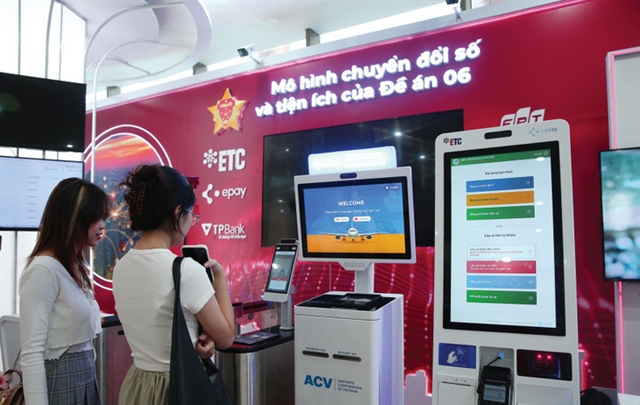 Business Beat
Business Beat

Overseas remittances to Việt Nam are expected to decline mainly due to global factors.
 |
The remittances come to Việt Nam mainly through four channels – banks, currently accounting for 72 per cent, economic organisations, customs agencies, and the postal system. — Photo vnexpress.net |
By Thiên Lý
Overseas remittances to Việt Nam are expected to decline mainly due to global factors.
Analysts said they include US President Donald Trump’s anti-immigrant policies, the US Federal Reserve’s policy of raising interest rates and the US-China trade war.
Statistics from the United Nations Development Programme show that 60 per cent of the remittances to Việt Nam comes from the US while Europe accounts for around 20 per cent. Other major sources are China, South Korea and Japan.
The remittances come to Việt Nam mainly through four channels – banks, currently accounting for 72 per cent, economic organisations, customs agencies, and the postal system.
Overseas Vietnamese living in the US, Canada, Germany and France account for the most remittances.
HCM City is consistently the largest recipient, accounting for almost half the remittances coming into the country last year with US$5.2 billion.
Last year total remittances were worth $13.78 billion, putting Việt Nam in the list of top 10 beneficiaries.
But things might get gloomier from here on, according to experts from the National Centre for Socio-Economic Information and Forecast (NCIF).
They said the major recent changes in the US are affecting remittances to Việt Nam since it accounts for a lion’s share of the amount.
The FED’s interest rate hike spree has made the greenback significantly more attractive, while Việt Nam’s own interest rates on the dollar still remains at zero.
This has meant many overseas Vietnamese are keeping their dollars back in their own country to benefit from the high interest rates instead of sending it to Việt Nam.
The US policy of restricting immigration and tightening borders is also negatively impacting remittance flows to Việt Nam because of the decline in the number of Vietnamese guest workers there.
The trade war between the US and China has led to the Chinese yuan’s depreciation, which is likely to affect Việt Nam’s economy since China is by far its biggest trading partner.
But other experts dismiss fears of declining remittances, saying they are not affected much by global economic occurrences.
Việt Nam’s sustained, rapid economic growth has enhanced confidence and attracted remittances, they said.
The country’s stock and real estate markets remain strong and would continue to attract overseas remittances despite US policies and global volatility, they said.
Consumer finance market running out of steam?
The consumer finance market has started showing signs of cooling down after a hot streak stretching several years as finance companies turn to reduce risks.
This is reflected by the market’s growth rate, which fell to below 5 per cent in the first half of the year, lower than the growth rate of banks.
In the past most finance companies were growing at double-digit rates.
But the first-half profits of FE Credit accounted for only 36 per cent of its parent VPBank’s total profits, much lower than the 50 per cent rate in recent years.
So why exactly are finance companies slowing down?
Many market observers blame it on the unsavoury reputation many have achieved because of their high interest rates and the tactics they use for debt collection, which is scaring away potential customers.
But others said that after their sustained hot growth, many finance companies have found it necessary to focus on risk management and improve their customer base.
The customer base is the group of customers who repeatedly purchase the goods or services of a business. These customers are a main source of revenue for a company. Companies with a customer base consisting mainly of large companies may increase their customer base by pursuing small and mid-size companies
By doing this, they are only making sure they are growing more safely and healthily, they said.
In the past finance companies used to lend to anyone who accepted their high interest rates, but are now becoming more selective and weighing risks more carefully.
Banks too are becoming more cautious about consumer loans.
Techcombank, for instance, has said it will only offer consumer loans for buying houses and cars and only against collateral.
A VPBank executive said the lender is constraining FE Credit’s growth pace and is happy to reduce its share in the bank’s consolidated profit.
The consumer lending market, driven by a rise in consumption and the country’s favourable demographics, has huge growth potential. It grew by a scorching 65 per cent last year after recording 50.2 per cent growth in 2016.
It is predicted to grow from the current VNĐ600 trillion (US$26.45 billion) to VNĐ1 quadrillion ($44 billion) next year, with the annual growth rate averaging 29 per cent.
Several banks have expressed keenness to establish consumer finance arms to grab a bigger slice of this pie, resulting in the mushrooming of such companies.
Foreign investors too have always been ready to enter this lucrative sector.
As a result, Việt Nam now has 17 consumer finance companies, including two new entrants, VietCredit and SHB Finance.
FE Credit is the biggest with a 48.4 per cent market share followed by Home Credit with 15.7 per cent, HS Saison with 12.3 per cent and Prudential Finance with 8.1 per cent.
Analysts said notwithstanding its great potential, the consumer finance industry in Việt Nam faces many challenges that do not seem easy for it to overcome and develop further.
The finance companies find it difficult to gather information about borrowers’ income to evaluate their credit score. What information they can get is not transparent.
The interest rates in Việt Nam are higher than in many other countries because of higher risks and inflation.
The interest rate on normal loans in the US is 0.25 per cent while the rate for consumer loan is 8-36 per cent. In China the respective rates are 6 per cent and 10-40 per cent.
But in Việt Nam, while the 2015 Civil Code caps the highest interest rate for civil interests rates at 20 per cent, consumer loans often carry interest rates of 55-84 per cent, equivalent to the rates loan sharks charge.
The high interest rates are one of the main reasons why many borrowers fail to repay, resulting in the increase in banks’ bad debts, experts said.
Another obstacle is that the legal framework has failed to keep up with the rapid development of the finance market and so fails to effectively protect both lenders and borrowers from risks.
To overcome these challenges, analysts underlined the need for the Government to strengthen the legal framework with new regulations governing fintech companies and new financial products such as P2P lending and crowd funding.
Improving public understanding of consumer lending and the culture of consumer lending, financial education and simplifying administrative procedures are also important, they said.
They suggested that banks, especially finance companies, need to further invest in technology to be able to collect information about potential borrowers and process them in a quick and efficient way that enables them to lend quickly while reducing risks for themselves. — VNS